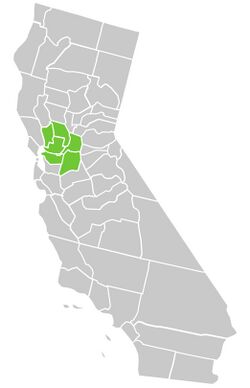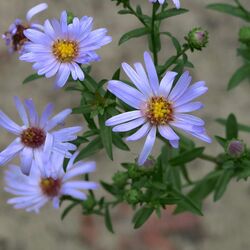Biology:Symphyotrichum lentum
| Symphyotrichum lentum | |
|---|---|

| |
| Scientific classification | |
| Kingdom: | Plantae |
| Clade: | Tracheophytes |
| Clade: | Angiosperms |
| Clade: | Eudicots |
| Clade: | Asterids |
| Order: | Asterales |
| Family: | Asteraceae |
| Tribe: | Astereae |
| Subtribe: | Symphyotrichinae |
| Genus: | Symphyotrichum |
| Subgenus: | Symphyotrichum subg. Symphyotrichum |
| Section: | Symphyotrichum sect. Occidentales |
| Species: | S. lentum
|
| Binomial name | |
| Symphyotrichum lentum (Greene) G.L.Nesom[2]
| |

| |
| Symphyotrichum lentum distribution by county in California [3] | |
| Synonyms[2] | |
| |
Symphyotrichum lentum (formerly Aster lentus) is a species of flowering plant in the family Asteraceae with the common name of Suisun Marsh aster.[4] It is a perennial and herbaceous plant endemic to the marshes of Sacramento-San Joaquin River Delta of Northern California.
Description
Symphyotrichum lentum is similar in appearance to Symphyotrichum chilense, which may be found in the same area. It is a colonial perennial herb producing a hairless stem 40 to 200 centimeters (1 1⁄4 to 6 1⁄2 feet) tall from a long rhizome. The leaves are linear or lance-shaped, pointed, and up to 15 centimeters (6 inches) long near the base of the plant. The lower leaves wither by the time the plant flowers. The inflorescence is an open array of flower heads with a fringe of violet ray florets around a center of yellow disc florets. The fruit is a hairy cypsela with a long white pappus.[5]
Distribution and habitat
Symphyotrichum lentum is endemic to the salt marshes and wet grasslands of the Sacramento–San Joaquin River Delta in Northern California.[5]
Conservation
NatureServe lists it as Imperiled (G2) worldwide.[1]
Citations
- ↑ 1.0 1.1 NatureServe 2022.
- ↑ 2.0 2.1 POWO 2019.
- ↑ CNPS, RPP 2021.
- ↑ USDA 2014.
- ↑ 5.0 5.1 Brouillet et al. 2006.
References
- Flora of North America Editorial Committee, ed. (2006), "Symphyotrichum lentum", Flora of North America North of Mexico (FNA), 20, New York and Oxford, http://www.efloras.org/florataxon.aspx?flora_id=1&taxon_id=250067659, retrieved 10 July 2021
- "Symphyotrichum lentum". Inventory of Rare and Endangered Plants of California. 2021. https://rareplants.cnps.org/Plants/Details/289.
- "Symphyotrichum lentum Suisun Marsh Aster". Arlington, Virginia: NatureServe. 3 June 2022. https://explorer.natureserve.org/Taxon/ELEMENT_GLOBAL.2.161292/Symphyotrichum_lentum.
- POWO (2019). "Symphyotrichum lentum (Greene) G.L.Nesom" (in en). Royal Botanic Gardens, Kew. http://www.plantsoftheworldonline.org/taxon/981854-1.
- "Symphyotrichum lentum". Natural Resources Conservation Service PLANTS Database. USDA. 2014. https://plants.usda.gov/core/profile?symbol=SYLE2.
External links
- Aster lentus protologue in Manual of the Botany of the Region of San Francisco Bay by Edward Lee Greene.
- Symphyotrichum lentum datasheet from the Centre for Agriculture and Bioscience International (CABI) Invasive Species Compendium.
Wikidata ☰ {{{from}}} entry
 |



